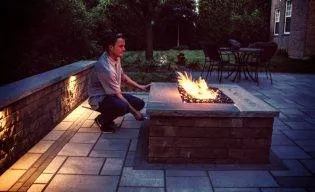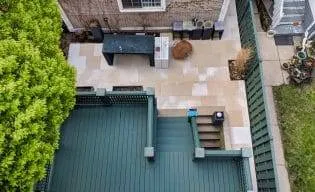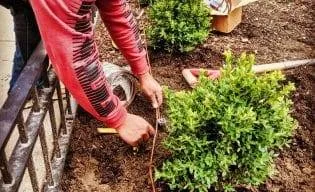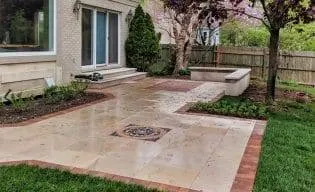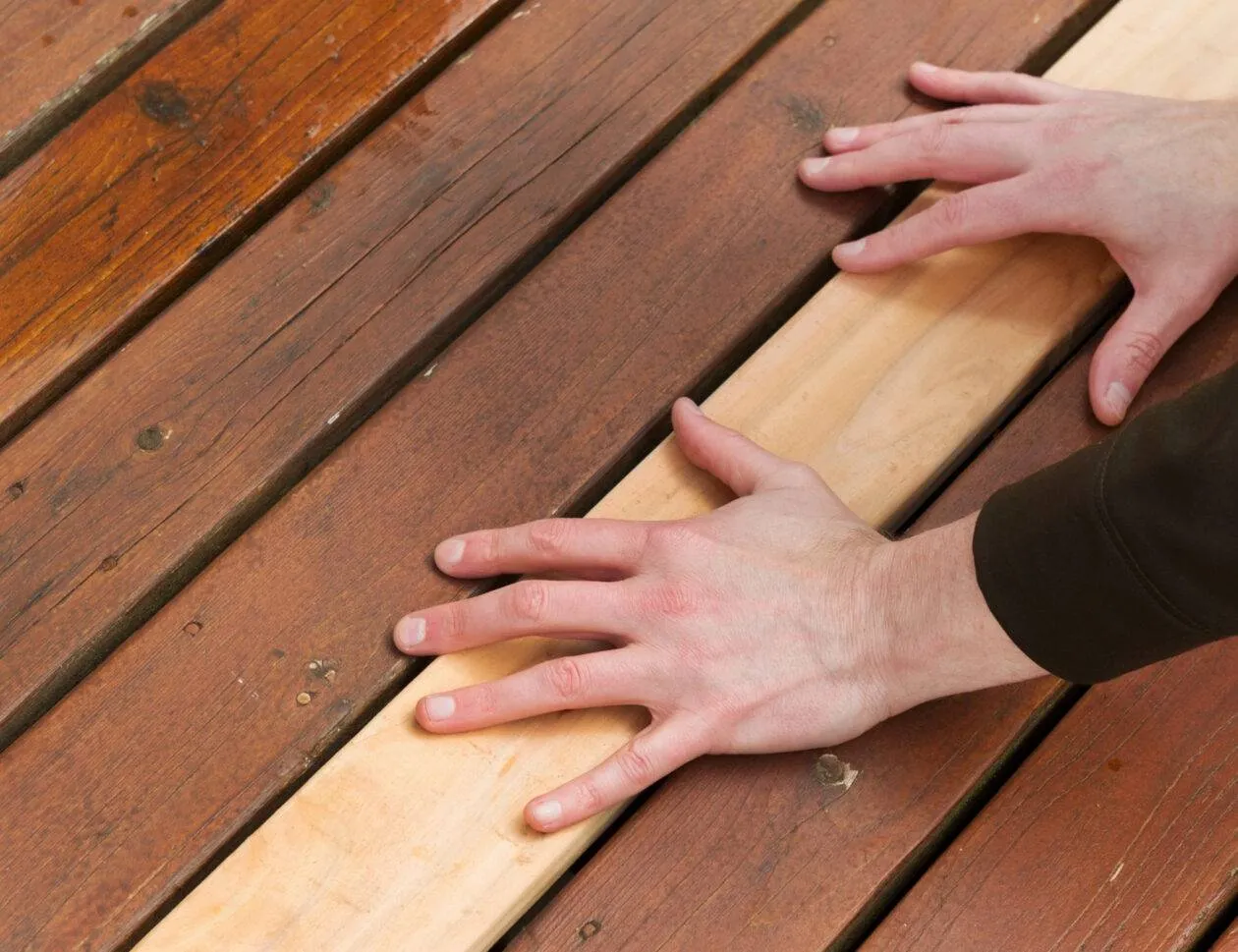Start Designing Your Outdoor Kitchen
Custom Outdoor Kitchen Design & Construction Services
Get Started
Your backyard becomes your favorite room when you build an outdoor kitchen. Morning coffee on the patio turns into routine. Summer cookouts happen on weeknights instead of just special occasions. Grilling in November becomes possible when you've got the right setup. Strong cooking smells - grilled fish, smoked brisket, anything fried—stay outside where they belong.
Wave Outdoors Landscape + Design builds outdoor kitchens in Mount Prospect that actually survive Chicago winters. We've spent years watching what fails here: April freeze-thaw cycles crack concrete, Lake Michigan humidity corrodes cheap stainless steel by year three, snow loads collapse structures sized for milder climates. Our exterior cooking spaces use 304-grade stainless minimum, proper drainage for spring snowmelt, and materials rated for 40-degree temperature swings in a single day.
Why Add an Outdoor Kitchen to Your Chicago-Area Home
You'll spend more time outside. The space you already have becomes usable in new ways. Lunch gets made where you're eating it. Evening gatherings happen naturally because setup isn't a production anymore.
Entertaining gets simpler. Everything sits at your fingertips - no running inside for forgotten ingredients while guests wait. You're participating in conversations instead of cooking in isolation. Summer parties no longer heat up your entire house.
Your property value increases. Outdoor cooking spaces return 55% to 200% of investment at resale according to National Association of Realtors data. Compare that to indoor kitchen remodels hovering at 54% return. Over 60% of homeowners now consider outdoor cooking areas essential rather than nice-to-have (Houzz 2024 research). In many Chicago suburbs, not having one actually hurts your listing compared to neighboring properties.
You can use it year-round with proper setup. Chicago winters aren't easy on exterior kitchens, but covered structures, strategic heating, and proper winterization let you grill in January if you want. Year-round functionality justifies bigger upfront investment when you're not limited to May through September.
What Outdoor Kitchen Installation Actually Includes
You're building a complete cooking space with appliances, outdoor cabinets for storage, prep areas, and utility connections that face weather your indoor kitchen never sees. The difference between backyard kitchens that last versus ones requiring major repairs within three years comes down to Chicago-specific construction: drainage systems handling snowmelt, materials surviving temperature extremes, wind protection that matters during November cooking sessions.
Layout Options for How You Actually Entertain
Perimeter kitchenettes sit against your house. Utility runs through exterior walls cost less than trenching across your yard. You save money on gas lines, electrical, and plumbing. Or you can use a propane tank for a simpler setup. You'll appreciate the convenience when you forget serving platters inside.
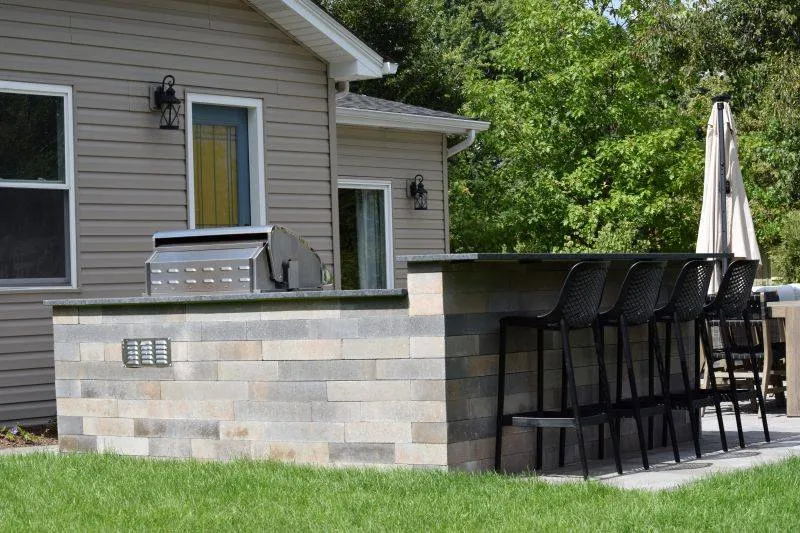
Satellite kitchens sit away from your house, creating destination spaces where guests gather without hovering near the back door. You'll pay more for trenching utility lines across your property, but you get privacy and that distinct outdoor room feel. We recommend these for larger properties where distance from the house creates real separation.
Common layouts we build:
- L-Shaped - Creates work triangles with counter space on two sides. Fits corner patios. Natural workflow between grill, prep, and serving areas.
- U-Shaped - Maximum counter space for multiple cooks. Best when you host large groups regularly. Requires more square footage but handles serious entertaining.
- Straight-Line - Keeps you facing guests while cooking. Lowest cost. Simplest install. Ideal for smaller patios or when space runs along one wall.
- Island - Provides 360-degree access. Becomes the gathering centerpiece. Needs open space on all sides. Works best for larger yards with room to walk around.
Each layout serves different entertaining styles. Our designers walk your property with you to figure out what fits your space and hosting patterns.
Core Components and Essential Features
Appliances
Built-in grills live permanently in your cooking space - not portable models you wheel around. For Chicago, you need 304-grade stainless steel minimum. Anything less corrodes within a couple years. Most homeowners size too small. Go larger when uncertain.
Natural gas never runs out mid-party but requires professional installation. Propane gives flexibility at the cost of periodic refills. Charcoal delivers flavor with hands-on management. These are just some of the options you have.
Pizza ovens hit 700 to 900 degrees, cooking authentic pizza in minutes. They also handle bread, roasted meats, anything benefiting from intense heat. Wood-fired versions need proper ventilation and clearance. Gas simplifies operation while maintaining high temps.
Power burners supplement your main grill for sauces, warming appetizers, cooking sides, handling frying tasks. High BTU outputs mean your sauce simmers while steaks grill. Multiple burners let you cook for crowds without overwhelming your main grill.
Countertops
Granite handles heat, resists scratches, survives freeze-thaw cycles. Needs periodic sealing but lasts decades. Concrete offers complete customization in colors and textures but requires proper sealing for Chicago winters. Quartz only works in covered areas - direct sunlight destroys it. Stainless steel (marine-grade 316 for Chicago) cleans easily and resists heat. Natural stone like bluestone provides unique patterns.
You need minimum 3 feet of counter space at 24-inch depth per cooking area. Insufficient workspace ranks as the top regret we hear. Plan it right during installation - modifying later costs a fortune.
An outdoor sink eliminates constant trips inside for rinsing and food prep. Chicago winters demand winterization. Drain lines before freezing temps, install shutoff valves in accessible locations, ensure proper drainage slope. Skip this and you're looking at burst pipes come spring.
Refrigeration and Storage
Outdoor-rated refrigerators work differently than indoor units - different insulation, different construction. Indoor refrigerators fail outdoors. Placement away from direct sunlight improves performance and cuts energy costs. Inadequate refrigeration ranks high among regrets - those constant trips inside defeat the point. For a simpler setup, you can also opt for a built in cooler.
Storage gets overlooked more than anything. Weatherproof cabinet materials include high-density polyethylene, stainless steel (304 or 316), and marine-grade polymer. You need space for cooking utensils, serving pieces, cleaning supplies, and food items. HDPE cabinets resist warping and fading. Stainless costs more but lasts. Marine-grade polymer balances weather resistance with lower maintenance.
Utilities: Gas, Electric, and Plumbing
Natural gas line installation requires professional work and permits in Chicago. The permanent connection means you never run out mid-cooking. Cost-effectiveness improves with frequent use. Installation costs vary by distance and complexity - long runs across your property cost more.
Portable propane systems offer a lower-cost, straightforward option for powering a built-in outdoor kitchen. A standard 20-pound cylinder can be stored in a vented cabinet within the island, providing convenience and easy refueling without major utility work. Larger permanent tanks (100–500+ gallons) connect through buried or above-ground lines to supply multiple appliances and require professional installation. Propane performs reliably even in Chicago winters, making it a practical alternative to natural gas for properties without an existing gas line. The lower initial investment of portable systems appeals to homeowners beginning with a smaller setup before expanding to a permanent supply.
Outdoor-rated electrical installations require GFCI outlets and weatherproof boxes. Proper amperage supports appliance demands. Electrical planning must occur before construction - adding circuits later increases costs significantly. Lighting circuits, appliance power, and entertainment system integration all demand adequate capacity.
Water supply lines and drainage systems serve outdoor sinks and appliances. Freeze protection proves crucial for Chicago installations. Winterization includes draining all water lines before first frost (typically late October or early November), leaving faucets open after draining to prevent pressure buildup. Professional installation prevents burst pipes and ensures proper drainage.
Comfort and Entertainment Features
Integrating dining spaces with cooking areas creates cohesive outdoor rooms. Bar seating at counters requires proper overhang dimensions. Separate dining tables provide additional seating. Built-in benches maximize space efficiency. Material choices for Chicago weather include powder-coated metal, weather-resistant wicker, and outdoor-grade wood with proper finishes. Three-foot clearances around seating prevent crowding.
Lighting Extends Evening Use
Under-cabinet LED strips, overhead grill lighting, and prep area illumination provide essential visibility for evening cooking. Most outdoor kitchen use occurs during evenings - proper lighting prevents accidents and enables proper food preparation in darkness. String lights, sconces, and landscape lighting transform dining areas. Pathway lighting, step illumination, and perimeter lighting prevent trips and falls. Chicago's early winter darkness increases safety lighting importance.
Smart Systems and Entertainment
Wi-Fi-enabled grills with temperature monitoring, smart lighting with app control, and automated shade systems enhance convenience. Outdoor-rated televisions, weather-resistant speakers, and projector systems keep gatherings outdoors. Entertainment systems prevent guests from drifting indoors during events. Television placement considers sun glare and viewing distances.
Weather Protection
Pergolas with open lattices offer partial shade and architectural interest. Support for climbing plants enhances aesthetics. Material options include cedar, composite, and aluminum. Average costs range from $2,220 to $8,960.
Permanent roof options include metal roofing, architectural shingles, and standing seam designs. Drainage system importance increases with Chicago snow loads. Solid roofs extend usage into rain and snow seasons.
Four-season and three-season room concepts incorporate insulated walls and retractable glass panels. Heating integration extends comfortable usage deep into winter. Wind protection matters particularly in urban areas subject to tunnel effects.
Safety Essentials
Clearance requirements from combustible materials prevent fire hazards. ABC-rated fire extinguishers provide emergency response capability. Proper ventilation prevents smoke accumulation. Vent hoods may be required by code when grills sit under roofs. Safe distances from house siding, fences, and overhead structures prevent fires.
Natural gas lines require professional leak detection. Propane tanks need visual inspection and proper storage. Carbon monoxide concerns increase in enclosed spaces. GFCI protection, weatherproof outlet covers, and proper circuit loading prevent electrical hazards. Non-slip flooring addresses Chicago ice and snow safety. Heat-resistant surface placement near grills prevents burns.
Planning Your Outdoor Cooking Area
Site Analysis
Evaluate available space with accurate measurements. Sun exposure assessment at different times prevents equipment damage. Wind pattern analysis informs protection requirements. Proximity to your house determines perimeter versus satellite cost implications. Existing utility access points affect installation complexity. Drainage assessment prevents water accumulation. Soil conditions influence foundation requirements.
Professional Design
Working with landscape design professionals enables 3D visualization before construction. Creating work triangles between grill, sink, and refrigerator optimizes workflow. Adequate counter space planning prevents regrets. Traffic flow design with three-foot clearances prevents crowding. Material selection appropriate for Chicago climate ensures longevity.
Budget Reality
In many U.S. markets (including metro areas similar to Chicago), residential outdoor kitchens commonly cost $7,000 to $50,000+, with many homeowners investing $10,000 to $25,000 for well-equipped, functional designs (grill, prep surfaces, storage, utilities). Start by prioritizing essentials—quality grill, counter/prep space, durable storage—and phase in luxury features later. Luxury add-ons such as built-in pizza ovens can add significantly (often $5,000 to $15,000+, and in very premium builds even $15,000–20,000 or more).
Material cost differences and site complexities matter. Permit fees typically range from a few hundred dollars up to a couple thousand depending on jurisdiction. Always build in at least 10% to 15% contingency (in challenging sites consider up to 20%).
Note: many published cost estimates do include labor and contractor installation, but design, engineering, and specialized trades (gas, plumbing, electrical) may be additional or only partially covered. Cutting corners on quality or skipping professional design often leads to premature replacement costs that exceed initial “savings.””
Permits
Chicago-area municipalities require different permits depending on your project scope:
- Electrical permits for outdoor wiring and lighting circuits
- Plumbing permits for water lines and drainage systems
- Gas line permits for natural gas installation
- Structural permits for covered structures and significant hardscaping
Proper permits protect you during construction and help at resale. Requirements vary by municipality—research your specific area before starting. Professional contractors handle filing, but homeowners can DIY if they understand local codes.
Winterization Checklist
Start winterization before first frost, typically late October or early November:
- Shut off water supply to outdoor sinks, refrigerators, ice makers at the main shutoff valve
- Drain all water lines completely—use compressed air for stubborn pockets
- Leave faucets open after draining to prevent pressure buildup from any remaining water
- Clean grills thoroughly before covering—food residue attracts pests and holds moisture
- Cover with breathable materials like canvas, not vinyl that traps moisture and causes rust
- Remove propane tanks and store in well-ventilated areas away from living spaces
- Check drainage around cooking area to ensure spring snowmelt flows away properly
Frozen pipes cause the most winter damage. Proper winterization prevents costly spring repairs that eat into your investment.
Maintenance
Spring startup requires reconnecting water, inspecting for winter damage, and deep cleaning surfaces. Summer upkeep involves regular grill cleaning, countertop sealing as needed, and checking gas connections. Fall preparation begins winterization, covers furniture, and stores accessories. Winter protection requires periodic snow removal and moisture checks under covers.
Wave Outdoors Designs Chicago-Ready Outdoor Kitchens
We've been building outdoor cooking spaces in Mount Prospect and surrounding Chicago suburbs for over five years. The difference between us and contractors who underestimate Chicago weather shows up three years later when your neighbors repair cracked countertops and we're still getting calls about how well everything held up.
Our process starts with 3D design so you see exactly what you're getting before we break ground. We handle everything: design, hardscaping integration, masonry, carpentry, lighting - which means one team that knows your property rather than five subcontractors who've never met.
The materials we specify aren't suggestions. When we recommend specific stainless steel grades or HDPE cabinetry over cheaper alternatives, it's because we've seen what fails here. Lake Michigan creates microclimates most contractors don't account for. Your backyard kitchen three blocks from the lake needs different considerations than one fifteen miles inland.
We're licensed, insured, and we warranty our work. Every project gets the same project management approach whether you're spending $15,000 or $250,000.
Tips & Tricks
- Last-Minute Deck Repairs Before Winter: What Can’t Wait Until Spring
- Chicago Roof Deck Builder: Designing & Installing Rooftop Decks
- Top 5 Deck Materials for Durability and Aesthetics
- The Ultimate Guide to Small Backyard Designs: Maximizing Space in Chicago’s Suburbs
- Creating Privacy in Your Chicago Outdoor Spaces
- Backyard Design: Creating Your Personal Outdoor Paradise
- Spring Landscaping
- Landscape Architecture


